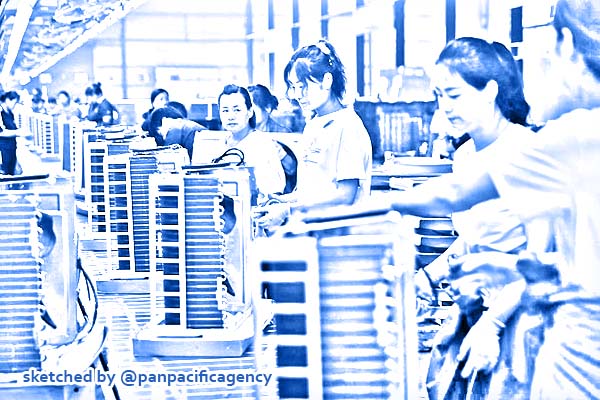[Analytics] China virus threatens to wipe out millions of businesses

Workers at a factory manufacturing air-conditioners in Huaibei, Anhui province, in China. The 11-page research report by China's Commerce Ministry notes how bilateral trade in goods has jumped 252 times to reach US$633.5 billion (S$864 billion) since both countries established diplomatic ties in 1979.PHOTO: REUTERS. Sketched by the Pan Pacific Agency.
Millions of small businesses in China could be destroyed by the coronavirus outbreak, which has swept across the country, threatening “social stability.” Painting a picture of industrial chaos, Huang Qifan, the vice-chairman of the National People’s Congress Financial and Economic Affairs Committee, warned that the impact of the newly-named Covid-19 disease was “scarier than the epidemic itself.” Gordon Watts specially for the Asia Times.
“If measures are not taken, a large number of small and medium-sized manufacturing enterprises will fail. Just as importantly, the industrial ecology of some of the more fragile manufacturing industries will be destroyed, leading to longer-term negative effects,” Huang, the former mayor of Chongqing, wrote on the Chinese-language Sina Finance website, which is linked to the Twitter-like Weibo social media app.
But manufacturing is not the only area of concern. Huang also highlighted the highly vulnerable service sector when he said:
“Consumption in hotels and cinemas has fallen sharply while a large number of small- and medium-sized enterprises are under extreme pressure as a result. For example, China’s tourism industry contributed slightly more than 11% to GDP in 2017.
“The number of direct and indirect people employed in the industry exceeds 100 million. If the sector is severely hit this time, unemployment will rise, increasing pressure on social stability across the whole of society.”
Beijing has already started to roll out a substantial stimulus package. But this will only kick-in once the country gets back to work, which is the elusive one-trillion-dollar question.
On Thursday, the number of deaths and new cases jumped significantly after President Xi Jinping’s government changed the metrics for monitoring the outbreak.
In Hubei province, which has become the epicenter of the epidemic, 242 people died in just one day as new patients infected by the disease reached nearly 15,000. Indeed, the surge fuelled speculation that the ruling Communist Party had under-reported the severity of the outbreak.
Only hours earlier, Xi and the powerful Politburo Standing Committee were calling for a tentative return to work program. The move came after Zhong Nanshan, a renowned scientist at China’s National Health Commission, issued a statement, saying that he thought the epidemic would peak later this month.
But the World Health Organization appeared horrified by the pronouncement and insisted the Covid-19 outbreak was “public enemy number one” and a “very grave threat.”
“I think it’s way too early to try to predict the beginning, the middle or the end of this epidemic right now,” Michael Ryan, the head of WHO’s health emergency program in Geneva, told a media briefing on Wednesday.
Since the first case in December was reported in Wuhan, the capital of Hubei province, the death toll has increased to nearly 1,500 with more than 65,000 people infected.
Economically, the impact looks certain to dwarf the financial fallout from Severe Acute Respiratory Syndrome, or SARS, which killed nearly 650 people across mainland China and Hong Kong between 2002 and 2003 with its flu-like symptoms.
While hard figures are even harder to predict, analysts have speculated on China taking at least a 2% hit in GDP growth this year, eating into previous forecasts of just under 6%.
But that does not factor in the great unknown of how long it will take to bring the disease under control.
“China’s economy is likely to contract sharply in the first quarter, as a result of the measures that have been taken to limit the spread of the new coronavirus. There is still a great deal of uncertainty about what will happen over the coming weeks, not least because it depends on the course taken by an infectious disease that is still poorly understood,” Mark Williams, the chief Asia economist at Capital Economics, a research consultancy based in London, said in a report.
“Using some fairly benign assumptions, we expect a decline in [year to year] growth from 6% at the end of last year to around 2% in [the first quarter]. That would be only a little bigger than the three percentage point slowdown during SARS. But in [quarter to quarter] terms, we think [that] output is likely to contract 2.5% [or] 10% at an annualized rate,” he added.
Politically, Beijing continued its cull of senior officials on Thursday after purging Party cadres in Wuhan in a move to shift the narrative away from the central government.
The official Xinhua news agency reported that Jiang Chaoliang, who was the Party secretary in Hubei, had been sacked and replaced by Shanghai Mayor Ying Yong. Ma Guoqiang, the CCP chief in Wuhan, was also “dismissed.”
Still, the scale of the crisis was perfectly articulated by Vice-Chairman Huang. With more than 56 million people in lockdown across China, he stressed:
“The epidemic is so dangerous and viral that it not only attacks the human body but also the national economy. We must all mobilize and prevent the risks to the country’s economy … and prevent the spread of the epidemic.”
After all, “stability” above everything else is paramount to the Party and the survival of General Secretary Xi’s administration.